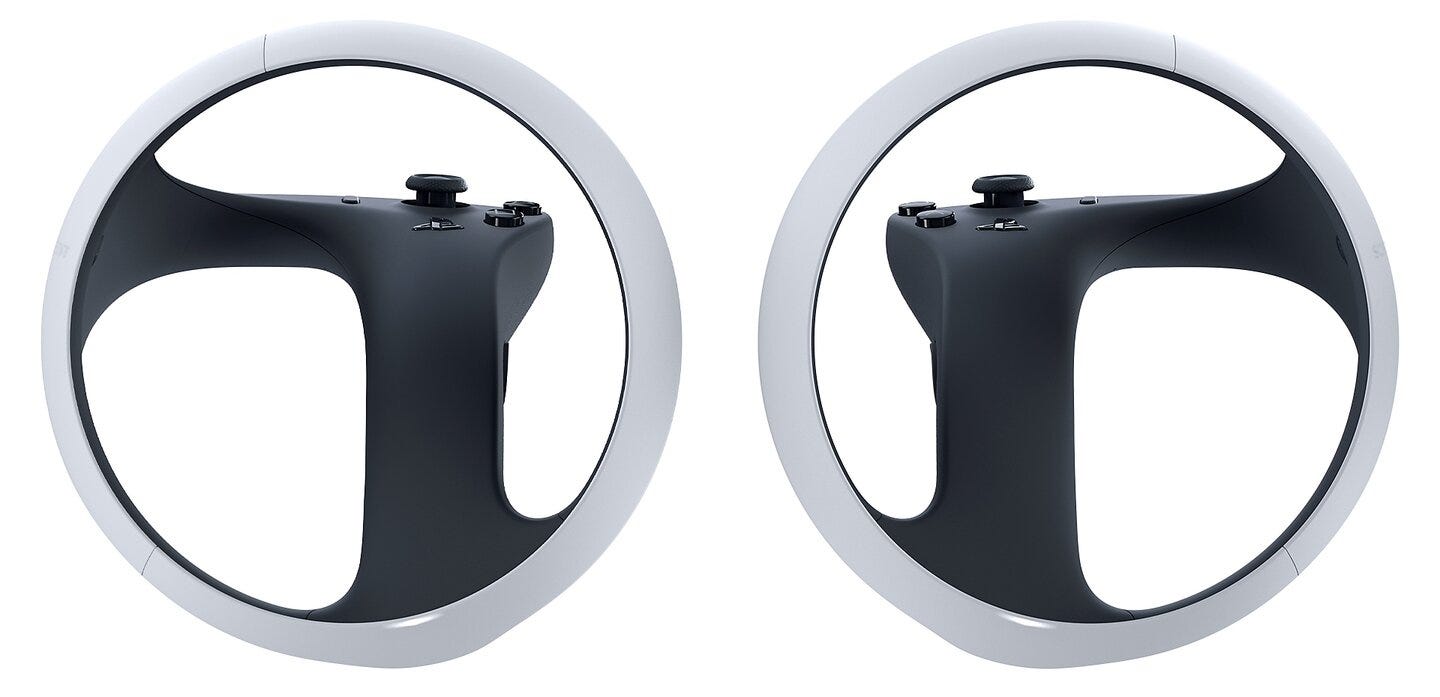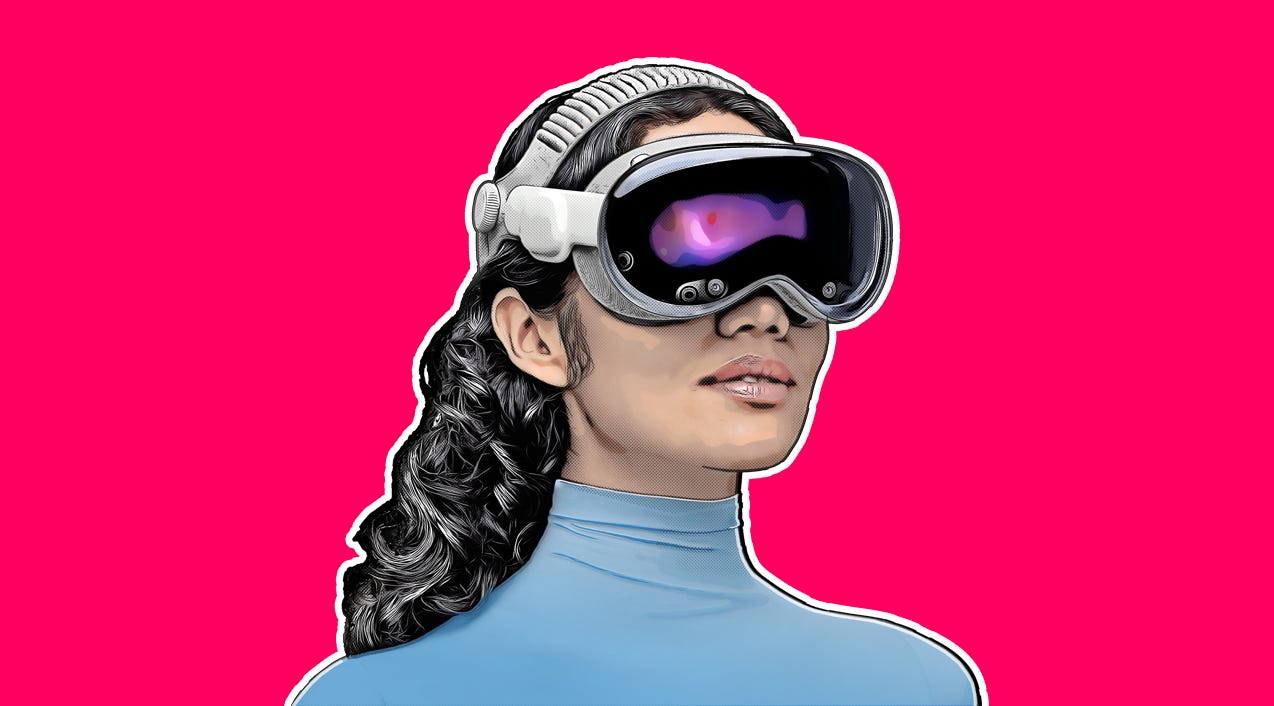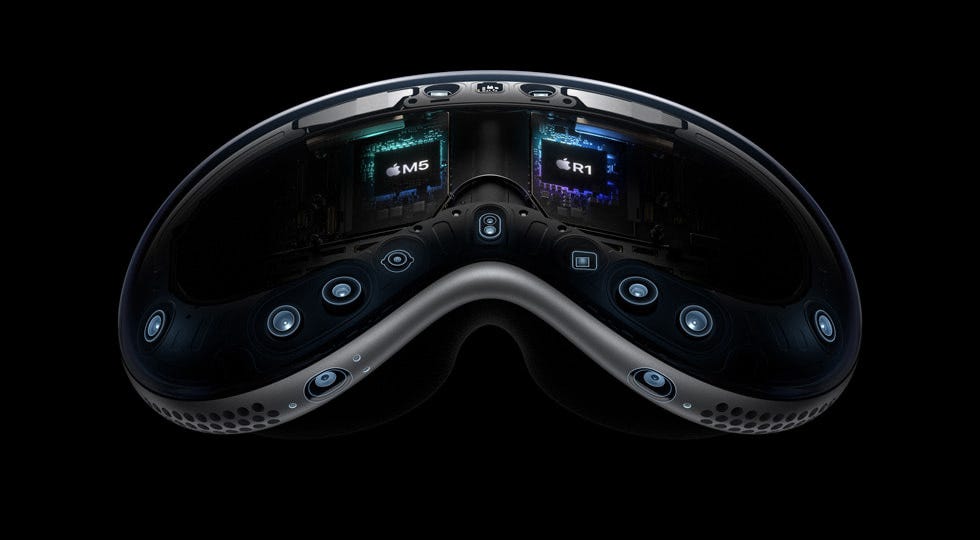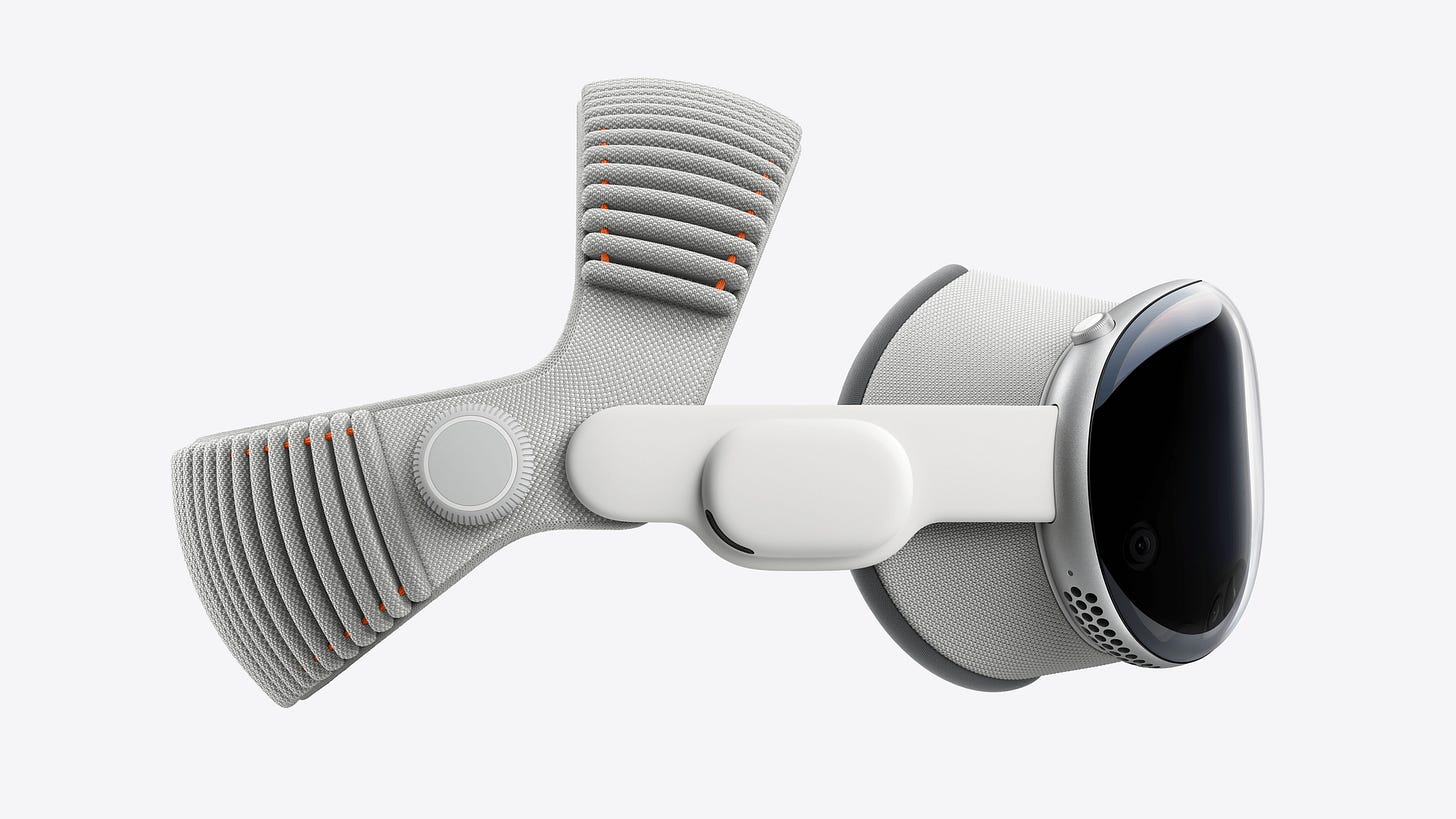Apple of your Eye? Looking behind the upgraded M5 Apple Vision Pro.
A glorious new fruit from the top of the tree, or just something from the bottom of the barrel?
Sometimes, it’s almost possible to feel sorry for Tim Cook. Only occasionally, mind you. While not really suffering any of the real-life hardships the rest of us sometimes do, he does seem to be wandering through a glorious eternal sunshine, yet remaining forever in the shadow of his predecessor. Even after all this time, it feels like he’s yet to conjure into existence that one thing we will all point to for the rest of our time as people on this earth (and I’m not taking bets on how long that might be but fingers crossed, eh?) and say ‘Cor! Look! That’s that thing that Tim Cook made! What a Legend’. Making a mark on the world is easy, but being remembered for it requires something monumental. He’s been trying for a while now.
This week marks 20 years with Cook at the helm of Apple’s operations (COO in 2005, and then as CEO from 2011) and, as Steve Jobs apparently worried at the time, it’s fair to say that he’s never really shown himself to be a particularly visionary product guy. While he’s an undeniably smart business man with a keen mastery of the complexities of global logistics and a far more democratic leadership style than Jobs’ more autocratic rulership, Cook has consistently proven to be more comfortable tending and nurturing a constant number of known product lines, rather than risking the kinds of innovative moon-shots that Jobs and his partner-in-vision Jonny Ives managed to continually surprise and delight consumers with.
While Jobs and Ives won hearts and market share with an innovation-first approach, Cook asserts that Apple “can only do a few things great”. But underneath it all, while he’s sailing on his solid gold Yacht powered by Manatees across the vast secret underground lake that lies deep beneath Apple’s curiously round-not-apple-shaped Cupertino headquarters1, I can imagine that he secretly yearns to be spoken of in the same breath as the Kings of old, rather than just being the cautious-but-successful Steward of their kingdom. While he grew Apple into the first $Trillion US company, none of the hardware lines he’s delivered have really had the same level of zeitgeist-shattering impact as the Mac, iPhone or iPad had in their day. Those that have arrived - Apple Watch, Airpods, Apple TV, AirTags, Siri, AR, Apple Intelligence, heck even Apple Maps - have been Apple-fied versions of other’s features and products already available on other devices.
Their recipe for success has switched from pioneer and lead to follow and improve. So while Cook has led Apple’s slice of the pie to get bigger, and they can arguably still lay claim to offering the best ingredients and customer experience on the market, it would be hard to argue that he’s tried to push any particularly bold new flavours. They’re great at polishing up and re-presenting existing tech by making it more sexy, appealing and user-friendly, and then selling it at a premium. All while pretending they came up with the idea first, of course - which for those outside of the Apple cult can be a particularly annoying trait. (I still remember my brother’s confused look after the announcement of Apple wireless charging in 2018, only for my to point at my 2 year old Samsung S6 which was sat charging wirelessly on the desk next to him).
28 months ago, Cook called the launch of Apple Vision Pro “the beginning of a new era for computing” - a statement which caused anyone who’d worked on, in or with VR at any point in the previous five decades to roll their eyes so hard they probably tore their rectus superior. And over the last couple of years, AVP has shown little sign of birthing any new era of anything, or even being able to compete in many of the same spaces as existing headsets. If you want fitness apps, games, or to enjoy the vast variety of VR and MR content that’s out there, the device doesn’t really measure up. And the things it does the best - watching movies and fitting seamlessly into existing workflows without much faffing - see their utility suffering greatly under issues of both the ergonomics of the headset and it’s battery life.
Anecdotally we’ve all heard of people who use it all day and never take it off, or who have chucked out their big-screen TV and replaced it with an AVP mixed reality version instead, but in reality I can’t imagine the physicality or logistics of this working out well for a significant number of people. As I wrote about extensively at the time, the high price and the fact that it simply couldn’t do a lot of standard VR things particularly well meant that this was a premium device that was selling itself on a very high quality but restrictively narrow user experience. It’s been fun to introduce the wider world of VR and MR features and use-cases to people whose only exposure to ‘spatial computing’ has been through AVP, and see their faces when a sub-£500 headset delivers powerful wows through gaming and exercise experiences the AVP can’t offer, and caters to a much broader number of use cases than the AVP can lay claim to at seven times the price. And in most cases, they notice the cheaper options and after-market upgrades are better balanced, and don’t feel as heavy on their cheekbones or nose, nor need such tight skull-clasping to keep them in place. The AVP and it’s in-headset, moment-to-moment experience are arguably lovely premium things indeed, and the tight integration that can be achieved with Apple-based workflows is definitely the direction we want to see other headsets going in on other ecosystems. But now, 2+ years in, with an estimated sales yield of less than 500,000 headsets sold, it’s easy to see why the public perceptions of the headset as being something of a misfire for Apple.
Alongside this, there’s been the explosion of MR spectacles supported by AI. Apparently this is the thing Tim Cook actually wanted to build all along, and AVP ended up as the chosen hardware because it was the closest achievable target when time came to lock down the product plans. Once Apple’s many competitors made that goal look achievable, a pivot away from the AVP approach was inevitable. In fact, according to Mark Gurman’s Bloomberg report from April, Cook reportedly “cares about nothing else” from a product development standpoint. He’s hell-bent on beating Zuckerberg to a pair of desirable smart glasses and capturing the market, thereby smothering any accusations from people exactly like me five paragraphs ago that he doesn’t have the same panache for ground-breaking products as Jobs. The pivot to chase his white whale makes sense, but it also runs the risk of leaving AVP high and dry. Nobody would have been surprised to just see Vision Pro get a lower price point with cheaper build materials, no creepy computer eyes on the front, and maybe a few downscaled specs, but be otherwise left to fend for itself while Cook pursued his true quarry.
So the announcement of the M5 Vision Pro update this week was kind of a surprise for a number of reasons. In no particular order -
Firstly, this wasn’t an on-stage announce, it was slipped out as a quiet press release, which is a big change from the fanfare and world-wide attention Apple conjured two years ago. This feels like Apple want to keep it on the down-low for now. It’s great that there’s a refresh coming but I guess any messaging here would basically boil down to “M5 chip um better”. Even so, Apple are no strangers to standing on the Cupertino stage and making a big show about minor upgrades so it feels a bit inauspicious.
Secondly, this isn’t just a tease for some future intent, it isn’t a device that’s still a year or more away. The M5 enabled headsets will be available to demo from today, 22nd October, at participating Apple stores (in the US, at least). That’s excellent, and from an image management POV it sidesteps a wave of speculative news stories and commentary that pre-announcements tend to generate, and which can spark inflated expectations and damaging prophecies of speculative doom, depending on the mood of the internet. I await some hands-on reports today or tomorrow with great interest, or the chance to go and try it for myself if it appears in the UK too.
Thirdly, there’s no price reduction. Seriously. That ever-so-affordable sweet spot of $3500 US that everybody loves isn’t changing. Apple’s Vision Air was expected as their next headset, and was rumoured to be landing with a price point somewhere just north of half of that price, a costed-down, de-specced version to broaden the market. The fact that Vision Air wasn’t mentioned, and is rumoured to have been back-burnered for now in favour of this M5 upgrade and MR glasses says to me that Apple aren’t looking to broaden their market for the device right now at all. One consideration here is that the AVP is so highly priced that even a 50% price-down would still make it very expensive for a consumer headset and still might not attract enough extra consumer and business sales to make up the shortfall. Another is that, while the price is the same, the spec is seeing at least a significant buff on the processing front, so it arguably qualifies as a worthwhile step forward for the device, and does offer better utility and value at that 😵🤯 price. I’m sure there’ll be a Vision Air at some point in the future, when Apple are more ready to confront the mainstream, but for now they’re playing it safe and not rocking the boat on price. It also affords them steadier waters on the product for the time being, while they concentrate on beating Zuck at the game of MR glasses. If that sounds like the device has been put into cruise mode to you, then you wouldn’t be alone.
Fourthly - As mentioned, the device is going from the M2 chip - which was an efficient fit for AVP’s daily use cases - to the newly announced M5 chip, which will also be under the hood of the new MacBook Pro and Ipad Pro. That’s a significant increase in power, far more capable of multithreading, giving better visual fidelity and more efficiency to run for longer and at lower temperatures - all of which could really elevate the AVP’s capabilities and day-to-day usefulness. Whether these will manifest as significant improvements to that user experience, or just slight bumps, we don’t yet know. But it’s probably the most enticing aspect of the announcement, and it certainly makes more sense to imagine the extra horses working under the hood of the Vision Pro than it does to have them in the new iPad Pro.
It should mean that, potentially, it’s going to be powerful enough to run some decent immersive gaming titles. Specifics aren’t yet clear but it’s a beast to be sure. But in a very Apple way, that’s not what Apple focus on first in the press release;
“Players will be able to enjoy iPad games like Where Winds Meet, POOLS, and Sniper Elite 4, fun spatial games like Porta Nubi and Glassbreakers: Champions of Moss, and the latest titles on consoles and PCs with apps like Portal and Steam Link. And with support for the PlayStation VR2 Sense controller, players get a new class of immersive games with high-performance motion tracking in six degrees of freedom, finger touch detection, and vibration support. Elu Legend, Pickle Pro, Ping Pong Club, and Spatial Rifts are some of the first games available with support for the PlayStation VR2 controller.”
They’re managing expectations here. iPad games they can get their heads around but I’m not sure immersive gaming conjures the same image for them as it does for many of us. But… it’s Apple and Games, right? It’s like the missing chunk of their DNA that they won’t accept. I’m not sure they’ll ever get why many customers enjoy them so much, and they’re resistant as ever to the idea that someone who spends multi-thousands on a super-capable laptop or spatial computing device might also be within their rights to expect it to be able to conjure something more sophisticated than just an iPad game. When they eventually mention some immersive games, they’re not headline titles, or even titles anyone will have heard of. Apple had a perfect opportunity to court some existing VR developers with bigger-name titles you might have heard of for this announce, but instead we get two racquet games and then whatever those other two might be. Not meaning to be cruel, and they might be wonderful games, but it does sound like they just grabbed the only 4 immersive games they could muster. If anyone else was announcing four launch titles for a new piece of hardware, they’d make darned sure every name was as much of a banger as they could find, and that the quartet did everything it could to cover the widest spectrum of appeal. Fingers crossed Apple can get their clown shoes off here, because there are a lot of talented VR devs out there who would love to see an easier path to bringing their content to the platform.

Fifth, there’s another key to this dev appeal. PSVR2 controllers will be available to buy ($250 US for the pair - yep, you read that right) imminently. Having VR controllers that just work with the device is essential, and even though AVP has supported these controllers since June, it’s a futzy, unreliable implementation currently. For the device to appeal to those who expect their expensive headset will have some parity of content with all the cheaper headsets, they simply have to nail this. Beyond that, being able to migrate existing controller-based games and apps on the new hardware without having to rethink it all to work with AVP’s native hand tracking is a positive factor that will attract more devs and established VR content to the platform. This is very good - but AVP always should have had some sort of standardised in-the-box physical controller solution, especially if they’re selling the immersion as a major selling point. And while this is a step forward, it remains an expensive optional bolt-on that will split the user base, so it’s not going to swing the needle much in terms of making the platform an attractive target for developers to port their existing titles over.
Again, it’s just Apple and Games, right? Despite what they must be raking in through games on the App Store, they never feel like they welcome gaming onto the platform. There’s a hint of it being beneath them still, always treated with a kind of curt and disdainful acceptance. I always imagine when the board meetings turn to gaming, the exec team all pull a snooty face like De Roche from Maestro VR. They look down their nose at it, grin and bear it, but you can tell that at an institutional level they’d really rather be doing anything else.
Bearing in mind that up until now PlayStation have not sold sets of replacement PSVR2 controllers (you’ve had to replace the whole headset), the news that they’ll cost $250 USD is going to get a lot of flack from PlayStationVR2 owners. No doubt there’s the Apple Tax built into that price but, of course, PlayStation won’t offer them cheaper to its own players. If you’re a Creative Pro or an Enterprise business and you’re fine with spending $3500 USD on a headset, another $250 USD isn’t an excessive bolt-on. But when looked at against the $399 USD retail price of the full PSVR2 package on the consumer front, it looks very different indeed. And with Samsung’s freshly revealed Galaxy XR also announcing controllers as an optional bolt-on at the same $250-per-pair price point today, it looks like this might become a standard baseline price for any pair of VR controllers. Meta currently sell individual controllers (L or R) for $75 USD each but it wouldn’t surprise me to see Meta hike their prices to match this new price point over time. It’s never been more important not to punch your walls, kids.
Sixthly (is that even a thing?), It’s got a new soft strap. I laughed so hard when I saw it because it really does look like a homebrew where someone just stitched two AVP straps together. I fail to see how this is going to help lift the headset’s weight from the front of the user’s face without those side arms being made of unbreakable vibranium, and even though I’m sure it will be more comfortable than either of the eventual solutions Apple offered on the first AVP, it still seems like they’re going out of their way to look acceptable in marketing photos, and not look too much like every other VR headset out there - many of which are rocking much more comfortable solutions. The good news is aftermarket suppliers have another easy fix they can charge Apple peripheral prices for, I suppose. The whole thing just boggles my brain a little though - getting a comfortable fit for the user is such a basic, essential requirement for a computer you have to strap to your face, and an uncomfortable fit is probably #1 or #2 in the list of issues that lapsed users will cite. And yet loads of headset manufacturers just don’t spend much effort addressing it and leave it to the after market, where they can throw out licenses and make free money by letting others solve the issue. But my question always is - why? Let’s get real. These are bits of fabric and plastic. Cheap, easy to produce. It’s an insane thing to skimp on when user comfort is such a high priority. If you want to read more about this particular area of annoyance for me, I had a good old grumble about it when the original AVP launched. In summary, that strap looks like a poor second attempt but we’ll know after users get their heads inside it for a few hours, one way or another.
Sometimes the best strategy is to do as little as possible
The M5 Vision Pro manages to be simultaneously encouraging and unexciting as an advancement of what is supposed to be the world’s premium consumer-adjacent VR headset. On the one hand, the M5 chip is going to make the AVP by far the most powerful standalone headset available, and will offer much more to warrant that price point. On the other hand, there’s very little other change evident here, and it feels a little like Apple couldn’t be bothered or didn’t know what else to do. Adding the M5 chip is a solid upgrade, but it’s disappointing that it’s being treated like just sticking in a new graphics card, or Sony putting out a Pro version of the PlayStation. It’s going to be better than the base model, but you know it’s a mid-gen refresh rather than a fully developed new revision, and so a lot of the issues and shortcomings that have been exhaustively covered over the last two years will remain unaddressed. If there are 500,000 AVP v1’s out there in the wild, it’s not clear who else this will be for. The bump in processing power, while welcome, wasn’t really at the heart of many people’s issues with it’s predecessor. The new headstrap, the awkward adoption of PSVR2 Sense controllers as non-essential but expensive bolt-ons, and the few nips and tucks here and there don’t seem to add up to a significantly better user experience of the kind that would turn the headset’s fortunes. And of course the new headset will impact prices of used AVP v1 kits significantly, which is a consideration for many owners thinking of upgrading, since it was announced today that Apple are offering no trade-in deal for the new AVP M5.
I know that a sizeable portion of the AVP user base is on the Enterprise and B2B side of the marketplace, rather than just XR enthusiasts, and for those markets this is a more appealing pitch if their AVPs are getting regular use. I do think this is where Apple’s core (lol) customers for this device are, and I think for now it’s probably the right strategic move for them to make. The XR kingdom is seeing the arrival of many new headsets over the next 12 months or so, with Samsung and Valve both having a lot to lose if they bungle their rollouts. They’ll fight harder and shout louder than Apple are interested in doing right now, because they have both more to lose and more to gain. Android XR is at a reset point again, while SteamVR is enjoying something of a revival. Neither maker can afford to neglect their markets or bungle their launches. Wherever Apple is at with AVP right now, they aren’t looking to reinvent or relaunch, just kindle the fire a little, keep the flame alive and steady, and maintain their current holding position.
At the same time, I’m disappointed. I get involved in all sorts of areas within the overall XR sphere, but my heart is still rooted in entertainment and gaming use cases, and so I do feel a big fat ‘ho-hum’ that Apple aren’t doing more to encourage existing XR devs to bring their experiences across. The subset of AVP owners who will also buy PSVR2 controllers and might buy your game is not going to be a big market, but right now many developers are working at a point where any new audience is going to be welcomed if it might help them survive or start to forge a new customer base. That market won’t get bigger on the platform without a body of content already being there to get the ball rolling. It’s what we call the classic chicken-laying-an-egg-with-a-catch-22-inside-of-it problem.
I asserted that Tim Cook’s not a visionary product guy, and I think we’re seeing that here. If there’s a bold next step for AVP, we’re not seeing much sign of it in this release. At the same time, he seems to be keeping a characteristically steady hand on AVP’s tiller, when many suspected it was sinking or already wrecked. If the dream that floats his (gold) boat is to beat Zuckerberg in the MR glasses market, Cook will already be aware that once we reach the paradise of full-vision MR through fashionable smart glasses at the end of the journey, every user is going to expect full, polished spatial integration of the virtual world and the real one. There’s still a long journey ahead of them to learn how to do that across a broader spectrum of use cases than what they’ve shown us so far.
Meta are sailing ahead on this front, and are also ahead of Apple on AI integration. In nautical terms, they have their shit wired tight. Apple are used to arriving late and planting their flag, but this apparent feistiness to beat Captain Zuck to the treasure suggests Tim Cook might be eyeing his big catch that will finally get him mentioned along with the greats. AVP may not ultimately represent Apple’s endgame for wearable computing, but it is certainly the most viable weapon they have to prepare for the MR battle ahead, and thus a necessary member of the fleet.
Maybe Tim Cook’s not a visionary product guy. But I do feel like he’s being a smart Captain in the course he’s charting right now, and if Apple catches the wind in time, it might all work out. If he finally wins the treasure and plants his MR flag first, laughing as Captain Zuckerberg flounders in the shallows, three important things will hopefully happen. He’ll earn his place next to Jobs in history and become less likely to end up as a footnote, he’ll be able to rest more easily on his underground golden manatee yacht, and I’ll be able to finally stop occasionally feeling sorry for him.
Until next time,
Jed
Jed Ashforth has been working in the games industry since 2002, and working with VR, MR and AR apps since 2010. He was part of the team that created PSVR at PlayStation, and has worked on around 150 XR projects. He has too many headsets but doesn’t have an Apple Vision Pro, although he happily accepts donations of them. He helps developers elevate their immersive and interactive experiences. If you’re interested to find out more you can reach him, and check out more of his work and articles, at www.realisedrealities.com.
All of my illustrations and text - in fact everything in this newsletter - is achieved without the use of AI. I like writing, and I enjoy doing graphic design. Call me human, but I like doing the fun bits myself. And I really wish someone would make AI that would just do the dishes and feed the cats while I got on with that.
Some of this is possibly not entirely true of course. One small giveaway we might focus on is the question of whether a yacht made of solid gold could even float, what with gold being 19x more dense than water. It raises too many questions. Unless, as I suspect might be the case, the secret underground lake is filled with lots and lots of really expensive bath salts. 🤔









I still love my "old" Apple Vision Pro and also interested in the new version with M5 Chip, which I tested last Wednesday at an Apple shop. Interesting is the PSVR2 Controller support with the new VisonOS 26 update indeed. I have tried with mine from the PSVR2 Bundle I had on the VisionOS 26 Beta, and it works after pairing!